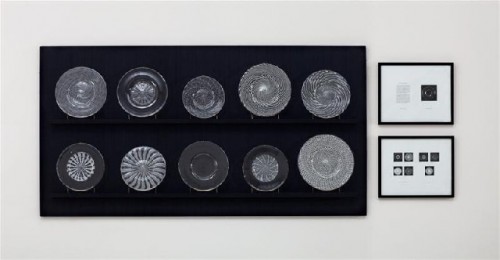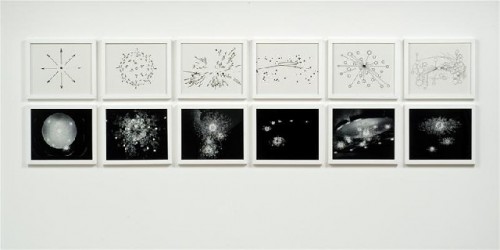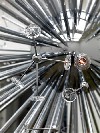Josiah McElheny at the Institute of Contemporary Art
Some Pictures of the Infinite
By: Shawn Hill - Jun 23, 2012
Josiah McElheny: Some Pictures of the Infinite
ICA Boston
June 22 – October 14, 2012
Those familiar with the McElheny works owned by the ICA and the MFA ("Czech Modernism" and "20th Century Modernism," respectively) may be surprised by the cosmic scope of this expansively logical showcase at the ICA. Not that the infinite wasn't a part of those endless reflections of mirrored past century perfection, but this broader collection spans art history from the Romans to the Renaissance to now and is influenced by the world of science from the microscopic to the literally universal.
Helping make sense of such breadth is McElheny's reliance on (or limitation to) monochrome simplicity. Most of the colors in the show are black, brown, gray or white, and that's because most of the materials are metal, glass, wood or paper. Through judicious use of glass-blowing, electric wiring and ink diagrams, McElheny has tapped into the ability of minimalism to suggest volumes; you can think of him on one level as simply a glass sculptor, but his conceptual approach allows him to create a variety of objects from the most antique of mirrors to accurate models of the Big Bang Theory that begat our universe.
"Four Mirrors after a poem by Jorge Luis Borges" (2000) is for me the heart of the show. Borges' poem deals with the terrors of reflective surfaces and the mirrors are made of glass, ebony, brass and mahogany respectively. The mirror is square, the brass is oval, and the two pieces of wood are rectangular. Each of them was the best surface available for self-examination in a long-past time and place, yet they all present the self with some degree of distortion. The ebony is perhaps the least distinct, just a glimpse into dark shadows, but the brass oval tints the world on the other side in gold.
In "Halo after Botticelli" (1997-99), McElheny creates a glass version of the Virgin's halo. The beautiful clear plate is rimmed and studded with a network of gold stars, a bit of heavenly matter somehow fallen to earth, fragility intact. His early glass works lead to recreations of other painted vessels, and to vessels filled with spiraling patterns that suggest different universal forces. Here he's conjuring ideas into solid, exceptional forms.
These explorations eventually lead McElheny to see cosmic patterns in the chandeliers of that premier bastion to modernism, the Metropolitan Opera House, and when you see his diagrams and his own versions inspired by those glittering decorative relics, it all starts to make sense.
There are two filmic elements to the show, both of which enhance the whole conception rather than distracting. One room finds six experimental, abstract films from the last 50 years (curated by Haden Guest of the Harvard Film Archive) projected on unusually shaped sculptural screens. With no narrative to follow, we instead are left to experience kaleidoscopic patterns and accompanying soundtracks, an ingenious use of video in a fine art context. There's no need to stay till the end, no story to construct, just images and sounds to experience. Another movie more traditionally animates the Met chandeliers into a stately dance, linking each mobile arrangement to a different theory of universal origin. It's a bit of a stretch, but a mesmerizing one, as these background elements take center stage.
And in the final room, near the ICA's beautiful waterfront exposure, five nearly 1-ton sculptures hang serenely from the ceiling to comprise "Island Universe" (2008). Each one represents a different mathematical theory of how Big Bangs might unfold, so we're really seeing in multiple dimensions, parallel galaxies as they form along slightly different principles. McElheny used actual theory to determine his shapes, which are branching globes of lights emerging from central silver spheres. Is it emotional projection on my part to find that "Heliocentric" (the model thought closest to our own reality, a nearly symmetrical sunburst) is comforting, while "Directional Structure" (where expansion is limited to a single orbital plane) and "Late Emergence" (with a sparsity of branches) seem unsettling and off-kilter?
Regardless, McElheny has found a variety of strategies for both offering a cool and intellectual respite from the summer heat, while allowing (through all those mirrored surfaces) for the human element to remain always present even in the most daunting of theories of the infinite.






